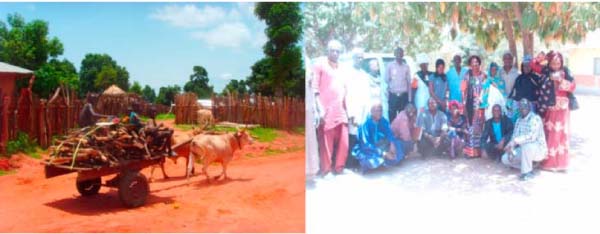
Regional
representatives involved in the production and marketing of firewood met at the
Pakalinding Trans-Gambia Lodge, in the Lower River Region, from the 17 to 21
March 2017 to revitalise the Firewood Producers and Marketing Association of
The Gambia.
The
programme with funding from the Food and Agriculture Organization of the United
Nations (FAO) through the Forest and Farm Facility (FFF) and the National
Farmers Platform of The Gambia (NFPG), aimed at revitalising and facilitating
the functionality of the association so that it could deal with relevant policy
and marketing issues for improved access and affordability of fuelwood by the
population.
Speaking
at the meeting, Kanimang Camara, the national facilitator of FFF, said the aim
of the workshop was to reflect on the past two decades of the activities of the
association, and the contribution of the firewood sector to food security and
nutrition, and to explore ways of strengthening these contributions through a
strong and vibrant local structure.
He said the workshop was expected to recommend
revision of the out-dated constitution and adopt a revise one based on current
circumstances and realities; restructure the organs and strengthen the capacity
of members on organisational skills for the development and effective
implementation of cross-sectoral policies on wood energy in enhancing access,
affordability to enable food security and nutrition at all levels.
“This
workshop comes at a timely period. As you may be aware, the recognition of
access to wood energy’s role in food security and nutrition is increasing. Appropriate cooking practices and access to
clean water ensure secure utilization of food absorption at an individual
level. Using of firewood for cooking is an important way of forests
contributing to food security and nutrition”.
He
said according to State of the World’s Forest (SOFO) 2014 report, over half of
the wood produced in the world is used for energy and one in three households
use wood as their main fuel for cooking.
“Wood
energy is often the only energy source in rural areas of less developed
countries, and is particularly important for poor people”.
The latter has particularly important
implications for food security and health, and in areas where fuelwood is
becoming scarce due to deforestation and forest degradation, people may revert
to eating fewer cooked meals.
With
growing populations in some parts of the world, wood fuel use is also a cause
of forest degradation.
In
Africa, 63.1 per cent of the population is dependent on wood fuel (fuelwood
& charcoal) for cooking, which is equivalent to 660 million people, the
highest share of dependency on wood fuel for cooking in Africa than any other
continents (Asia and Oceania: 38.4 per cent in Latin America and the Caribbean.
In
The Gambia, over 85 per cent of the population is as well dependent on firewood
for cooking, which is equivalent to 1, 530,000 people.
Affordability
and access to firewood seems challenging for many urban dwellers and the
sectors’ full contribution to sustainable livelihoods, including food security
and nutrition are undervalued/ underestimated.
Lamin
Sawaneh, the regional forestry officer (RFO) for LRR mentioned that the price
increase of firewood had a significant impact on consumer attitude.
Since the past twenty years, branch firewood
is becoming more popular and represents about 25 per cent of total firewood
sales.
“This
is probably strongly underestimated as much of the branch wood is still
escaping the official taxation and monitoring system, because it is transported
in small quantities.”
Both the price increase and the demand for
branch wood constitute a formidable opportunity for sustainable community
forestry in The Gambia, he said.
Mr
Fatajoh, representing the Ministry of Energy re-echoed the institutional
mandate of his ministry, especially in the area of alternative energy sources
such as the introduction of various prototypes of improved stoves to reduce the
dependency on firewood.


